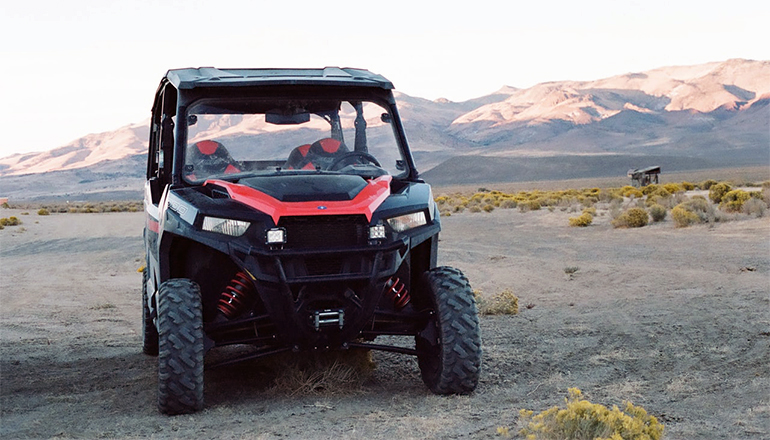The superintendent of the Missouri State Highway Patrol would like to remind the public about laws pertaining to the use of all-terrain vehicles and utility vehicles.
Missouri laws define utility vehicles as any motorized vehicle manufactured and used exclusively for off-highway use, which is more than 50 inches, but no more than 80 inches in width, with an unladen dry weight of 3,500 pounds or less, traveling on four or six wheels, to be used primarily for landscaping, lawn care, or maintenance purposes. The width is measured from the outside of the tire rim to the outside of the tire rim.
Utility vehicles can be operated on the highway if owned and operated by a governmental entity for official use, and for agricultural purposes or industrial on-premises purposes between official sunrise and sunset. (Can operate at night if equipped with proper lighting.)
Utility vehicles may also be operated within three miles of the operator’s primary residence. The provisions of this subdivision shall not authorize the operation of a utility vehicle in a municipality unless such operation is authorized by such municipality.
A UTV driver must possess a valid driver’s license to operate on the highway. A valid driver’s license is NOT required when operated by handicapped persons for short distances occasionally, only on the state’s secondary roads (state’s lettered routes), and only between the hours of sunrise and sunset.
Cities may issue special permits to operate on the highways within city limits by a licensed driver. Counties may issue special permits to operate on county-maintained roads. Municipalities may by resolution or ordinance allow utility vehicle operation on the streets or highways under the governing body’s jurisdiction. Any person operating a UTV pursuant to a municipal resolution or ordinance shall maintain proof of financial responsibility.
Utility vehicles cannot be operated at speeds greater than 45 miles per hour. Operators must obey the rules of the road (use turn signals, obey stop signs, etc.). It is illegal to operate a UTV while under the influence of drugs or alcohol.
Additional requirements for UTVs include:
A slow-moving triangle is required only if operating under 25 mph after sunset to one-half hour before sunrise. This does not apply to dirt or gravel-surfaced roads.
UTVs cannot be operated in a stream or river, unless the waterway flows within the boundaries of land, which the operator owns, or upon the land owned by another for agricultural purposes with permission from the landowner.
Missouri law defines all-terrain vehicles as any motorized vehicle manufactured and used exclusively for off-highway use, with an unladen dry weight of 1,500 pounds or less, traveling on three, four, or more nonhighway tires, with either a seat designed to be straddled by the operator and handlebars for steering or a width of 50 inches or less measured from the outside of the tire rim to the outside of the tire rim, regardless of seating or steering arrangement.
Those operating an ATV must possess a valid driver’s license to operate on the highway; however, a valid driver’s license is NOT required when operated by handicapped persons for short distances occasionally, only on the state’s secondary roads (state’s lettered routes), and only between the hours of sunrise and sunset. ATVs cannot be operated on the highway at speeds greater than 30 mph. In addition, it is illegal to operate an ATV while under the influence of drugs or alcohol.
An ATV operator must obey the rules of the road (use turn signals, obey stop signs, etc.). Missouri law also requires:
- A bicycle safety flag is mounted on the rear of the vehicle for operation on the highway. The flag must extend not less than seven feet above the ground, be triangular, have an area of not less than 30 square inches, and shall be day-glow in color.
- Helmets for drivers under 18 years old.
- A lighted headlamp and taillamp any time it is operated on the highway or street.
- An equilateral triangle is displayed on the rear of the vehicle at least two feet above the road. It shall be fluorescent yellow-orange and have a reflective red border at least one inch in width. Each side shall measure at least 10 inches.
- A braking system is maintained in good operating condition.
- An adequate muffler system in good working order and a U.S. Forest Service-qualified spark arrester.
- Be registered with the Department of Revenue (sticker).
Passengers are NOT allowed, except for farm purposes, unless the seat is designed to carry more than one passenger. ATVs cannot operate in a stream or river, unless the waterway flows within the boundaries of land the operator owns, or upon land owned by another for agricultural purposes with permission from the landowner.
An ATV can be operated on the highway:
- If it is owned and operated by a government entity for official use.
- For agricultural purposes or industrial on-premises purposes between official sunrise and sunset.
- If a city has issued a special permit to operate on the highways within city limits by licensed drivers.
- If a county has issued special permits to operate on county-maintained roads.
- If a municipality, by resolution or ordinance, allows ATV vehicle operation on the streets or highways under the governing body’s jurisdiction. Any person operating an ATV pursuant to a municipal resolution or ordinance shall maintain proof of financial responsibility.
While there is no age requirement for driving an ATV, this does not mean a child of any age can safely operate one. It is the responsibility of the parents to make sure their children are prepared mentally and physically to drive an ATV. These vehicles come in many sizes, and it is important to match the rider with the ATV. The Patrol strongly urges parents to have their children attend a certified safety course before operating an ATV. As with operating any vehicle, safety should come first.
(Photo by Emmy Gaddy on Unsplash)


